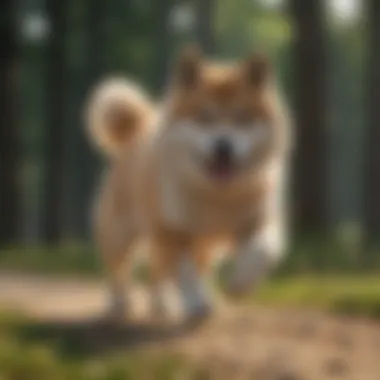Unlocking the Secrets of Effective Akita Training for Dedicated Dog Owners


Animal Species Profile
Akita dogs are a beloved canine breed cherished for their exceptional intelligence and unwavering loyalty. Their striking appearance and imposing stature make them standout creatures in the dog world. Originally hailing from Japan, Akitas have a rich history intertwined with their role as protective and faithful companions.
Physical Characteristics and Appearance
Akitas are robust and powerful dogs, known for their muscular build and strong bone structure. They typically have a broad head, pointed erect ears, and distinctive triangular eyes that exude wisdom and alertness. Their double coat, consisting of a thick undercoat and a coarser outer layer, provides insulation against harsh weather conditions, enhancing their endurance and resilience.
Natural Habitat and Distribution
In their native Japan, Akitas were primarily bred for hunting large game such as bears and boars. Their agility and fearlessness made them well-suited for navigating rugged terrains and dense forests. While originally found in mountainous regions, Akitas are now cherished as domestic companions worldwide, adapting to various environments and climates.
Behavior and Social Interactions
Akitas possess a unique blend of independence and loyalty. They are known to be dignified and aloof towards strangers but deeply devoted and affectionate towards their family members. Understanding their pack mentality is crucial in training Akitas, as they thrive in environments with clear leadership and consistent boundaries. Their innate protective instincts and keen intuition underscore their remarkable ability to bond closely with their human counterparts.
Introduction
In the realm of dog training, understanding the nuances of working with specific breeds is paramount to success. In this article, we delve into the intricacies of training Akita dogs, creatures known for their remarkable intelligence and unwavering loyalty. The bond between an Akita and its owner is a special one, built on trust, respect, and effective communication. By exploring the unique characteristics of the Akita breed and implementing proven training techniques, dog owners can nurture a harmonious relationship with their Akita companions that thrives on mutual understanding and cooperation.
Understanding the Akita Breed
The History of Akita Dogs
Delving into the historical lineage of Akita dogs reveals a fascinating tale of noble heritage and resilience. Originating in Japan, Akitas were revered as symbols of strength and protection, guarding royalty and nobility with unwavering loyalty. Their history is steeped in tradition, with a rich legacy of bravery and tenacity. This robust history shapes the Akita breed's current characteristics, instilling in them a sense of dignity and pride that defines their demeanor. Understanding the roots of Akitas provides valuable insights into their nature, highlighting why they make exceptional companions for dedicated dog owners.
Key Characteristics of Akitas
Akitas are renowned for their distinctive characteristics that set them apart from other breeds. Their stoic demeanor, coupled with a keen intellect, makes them intriguing yet challenging companions. Known for their independent spirit and unwavering loyalty to their family, Akitas exhibit a unique blend of endearing qualities and formidable presence. Their protective instincts and gentle demeanor towards loved ones make them cherished members of the household. However, their strong will and assertiveness require skilled handling and understanding. Recognizing these key characteristics of Akitas is pivotal in developing a successful training regimen that caters to their specific needs.
Preparing for Training
Creating a Positive Training Environment
Establishing a positive training environment is foundational to successful Akita training. Akitas respond best to training when they feel safe, secure, and valued. Creating a space that fosters trust and encourages learning is essential for effective communication between dog and owner. By setting clear boundaries, offering consistency, and utilizing positive reinforcement techniques, owners can cultivate a nurturing training environment that promotes a strong bond and mutual understanding.
Gathering the Necessary Training Tools
Equipping oneself with the essential tools for Akita training is a crucial step towards success. From durable leashes and harnesses to high-value treats and engaging toys, having the right gear can enhance training sessions and improve communication between owner and pet. Each tool serves a specific purpose in the training process, aiding in reinforcing positive behaviors and correcting unwanted ones. Choosing appropriate training tools tailored to the Akita's temperament and learning style is key to achieving desired training outcomes.


Training Techniques
Training techniques play a pivotal role in shaping the behavior of Akita dogs, known for their intelligence and loyalty. Effective training methods are essential for fostering a strong bond and ensuring a harmonious relationship between Akita dogs and their owners. By employing the right techniques, dog owners can nurture the innate abilities of Akitas and facilitate their learning process. Understanding the significance of training techniques is key to successfully training Akita dogs.
Basic Commands
Sit, Stay, Come
Sit, Stay, and Come are fundamental commands that form the basis of obedience training for Akita dogs. These commands enhance communication between the owner and the dog, enabling better control and cooperation. Sit teaches the dog to sit on command, Stay instructs the dog to remain in place, and Come calls the dog back to its owner. These commands are indispensable for managing the dog in various situations and fostering discipline.
In training Akitas, Sit, Stay, and Come are crucial commands that contribute to building a solid foundation of obedience. They help establish boundaries, improve responsiveness, and promote good behavior. The consistency in practicing these commands instills a sense of reliability in the dog, strengthening the bond between the dog and its owner. Despite their simplicity, Sit, Stay, and Come are powerful tools in shaping the behavior of Akita dogs, making them essential for effective training.
Down, Heel, Leave It
Down, Heel, and Leave It are advanced commands that enhance the training experience for Akita dogs. Down instructs the dog to lie down, Heel teaches the dog to walk closely beside the owner, and Leave It commands the dog to ignore distractions. These commands are valuable for instilling discipline, improving focus, and managing unwanted behaviors.
When training Akitas with Down, Heel, and Leave It, owners can expect heightened levels of obedience and attentiveness from their dogs. These commands provide a higher degree of control in various situations, enhancing the safety and well-being of the dog. Incorporating Down, Heel, and Leave It into training sessions challenges the dog mentally and physically, contributing to a well-rounded training regimen.
Positive Reinforcement
Using treats effectively
Using treats as a form of positive reinforcement is an effective strategy for motivating Akita dogs during training. By rewarding desired behaviors with treats, owners can encourage and reinforce good conduct. Treats act as incentives that prompt Akitas to engage in behaviors that are pleasing to their owners, making the training process more enjoyable and rewarding.
Leveraging treats effectively in training sessions creates a positive association with learning for Akita dogs. The use of treats not only motivates the dog but also facilitates quicker learning and retention of commands. Employing treats strategically can help shape desired behaviors and build a stronger bond between the owner and the dog, making it a valuable tool in training Akitas.
Praising and rewarding good behavior
In addition to treats, praising and rewarding good behavior are essential components of positive reinforcement for Akita dogs. Verbal praise, petting, and playtime serve as alternate rewards that reinforce desired actions. Acknowledging good behavior with positivity enhances the dog's confidence, strengthens the owner-dog relationship, and fosters a cooperative attitude in the dog.
Praising and rewarding good behavior contribute significantly to the emotional well-being of Akita dogs and deepen the connection with their owners. These forms of reinforcement create a supportive and encouraging training environment, motivating Akitas to perform well and seek approval. Integrating praise and rewards into training sessions instills a sense of accomplishment in the dog and reinforces positive behaviors.
Socialization Skills
Exposing Akitas to various environments
Socialization plays a vital role in shaping the behavior and temperament of Akita dogs. Exposing Akitas to different environments, stimuli, and experiences from a young age helps them become well-adjusted and confident. By introducing Akitas to various settings, owners can prevent fearfulness and aggression, promoting a well-socialized and adaptable companion.
Exposing Akitas to diverse environments is crucial for enhancing their social skills and reducing anxiety in unfamiliar situations. It broadens their understanding of the world and fosters tolerance towards new stimuli. Through gradual exposure and positive reinforcement, owners can help Akitas develop into well-rounded and sociable dogs, capable of navigating diverse social interactions.
Interacting with other dogs and people


Interacting with other dogs and people is essential for developing the social skills of Akita dogs. Positive interactions with conspecifics and humans promote good manners, reduce aggression, and encourage friendly behavior. Socializing Akitas early and frequently contributes to their ability to communicate effectively, form strong bonds, and establish harmony in social settings.
Encouraging interactions with other dogs and people allows Akitas to learn appropriate behavior, communication cues, and social etiquette. It enhances their emotional intelligence, builds confidence in new environments, and fosters acceptance of diverse personalities. Regular and supervised socialization experiences play a key role in shaping the sociable and well-mannered nature of Akita dogs, enriching their overall quality of life.
Common Challenges
In the realm of Akita dog training, addressing common challenges is a pivotal aspect that every owner must navigate. Understanding the unique behavioral traits and tendencies of Akitas can help in preemptively managing issues such as aggression, separation anxiety, and excessive barking. By delving deep into the psyche of these remarkable dogs, handlers equip themselves with the knowledge and foresight required to nurture a harmonious companionship.
Aggression
Understanding Triggers
When it comes to decoding the intricate nature of aggression in Akitas, pinpointing triggers is of utmost importance. By recognizing specific stimuli that provoke aggressive responses in Akitas, owners can effectively manage and potentially diffuse confrontations. Understanding triggers allows for proactive intervention and tailored strategies to redirect negative behaviors into positive outcomes. This segment sheds light on the nuanced interplay between stimuli and reactions, offering insights into mitigating aggression for a well-balanced relationship with your Akita.
Seeking Professional Help if Needed
Navigating complexities within an Akita's aggressive tendencies may necessitate professional intervention. Seeking expertise from qualified professionals can provide tailored solutions and behavioral modifications that align with the individual needs of your Akita. Professional guidance ensures a holistic approach towards addressing aggression, safeguarding both the dog and owner's well-being. This section underscores the significance of recognizing when external support is crucial in managing aggression effectively.
Separation Anxiety
Coping Strategies for Owners
Addressing separation anxiety in Akitas requires a multifaceted approach, encompassing emotional support and strategic coping mechanisms for owners. Implementing coping strategies involves fostering a secure environment and establishing routines that alleviate anxiety triggers. By actively engaging in practices that nurture independence and emotional resilience in Akitas, owners can mitigate separation anxiety and promote mental well-being for their cherished companions.
Gradual Desensitization Techniques
Gradual desensitization techniques serve as a cornerstone in acclimating Akitas to periods of separation and reducing anxiety levels. By incrementally exposing Akitas to varying durations of alone time and employing positive reinforcement, owners can instill confidence and comfort during absences. This methodical approach cultivates a sense of security and self-assurance in Akitas, facilitating a smoother transition towards independence. The strategic application of gradual desensitization techniques fosters resilience and psychological balance in Akitas.
Excessive Barking
Identifying Root Causes
Unraveling the underlying causes of excessive barking in Akitas demands a keen observation of behavioral triggers and environmental stimuli. Identifying root causes involves discerning between alert barking, territorial behavior, and anxiety-induced vocalizations. By grasping the motivations behind excessive barking, owners can tailor training interventions that address specific triggers and promote quieter, harmonious environments for both the Akita and its surroundings.
Training Exercises to Reduce Barking
Implementing targeted training exercises offers a proactive approach to curbing excessive barking tendencies in Akitas. By engaging in reward-based training focused on quiet commands and positive reinforcements, owners can redirect excessive barking behaviors effectively. Training exercises not only enhance communication between owners and Akitas but also foster mental stimulation and behavioral discipline. This section elucidates practical exercises designed to channel an Akita's vocal expressions positively and foster a serene living space.
Advanced Training
In the realm of enhancing your Akita's capabilities, advanced training plays a pivotal role. This section delves into the intricacies of sharpening your Akita's skills beyond the basics, elevating their mental acuity and physical prowess. Incorporating advanced training techniques is essential in channeling your Akita's intelligence and loyalty effectively. Not only does advanced training challenge your dog, but it also fosters a deeper understanding between you and your Akita companion.


Agility Training
Introduction to agility equipment
Agility training involves introducing your Akita to various apparatus like hoops, tunnels, and weave poles, aiming to enhance their agility and balance. The utilization of agility equipment provides mental stimulation and boosts coordination in Akitas. The key characteristic of agility equipment lies in its ability to mimic real-world obstacles, preparing Akitas for diverse environments and boosting their problem-solving skills. While agility equipment is beneficial in enhancing physical fitness, its drawback may lie in the need for adequate space and supervision to ensure safe training sessions.
Building Akitas' physical and mental skills
Building your Akita's physical and mental skills involves activities like obstacle courses, mental puzzles, and balance exercises. This aspect contributes significantly to the overall training by improving your Akita's strength, endurance, and cognitive abilities. Strengthening physical and mental skills is a popular choice for this article as it aligns with the breed's active nature and desire for mental challenges. The unique feature of this training is its holistic approach, catering to both the physical and mental well-being of Akitas. While advantageous in overall development, intensive physical training may pose a risk of overexertion without proper monitoring.
Obedience Competitions
Preparing for competitions
Preparing Akitas for obedience competitions involves rigorous training sessions focusing on precision, timing, and performance under pressure. This aspect contributes by refining your Akita's obedience skills and ensuring they are competition-ready. The key characteristic of competition preparation lies in instilling a sense of discipline and responsiveness in Akitas, essential for excelling in competitive environments. While preparing for competitions is beneficial in enhancing your Akita's skills, it may be demanding in terms of time and effort.
Showcasing obedience and skills
Showcasing your Akita's obedience and skills in competitions demonstrates the culmination of dedicated training efforts and the bond between you and your dog. This aspect highlights the unique abilities and talents of Akitas, emphasizing their intelligence and adaptability. The distinct feature of showcasing obedience lies in the platform it provides to exhibit your Akita's capabilities in a competitive setting. While advantageous in celebrating your Akita's achievements, the competitive nature of such events may induce stress in some dogs.
Advanced Commands
Mastering complex commands
Mastering complex commands entails teaching intricate actions like paw signals, spins, or heelwork, pushing your Akita's learning boundaries. This aspect contributes by refining your Akita's responsiveness and expanding their repertoire of behaviors. The key characteristic of mastering complex commands lies in fostering communication and mutual understanding between you and your Akita. While advantageous in showcasing advanced skills, the complexity of commands may require patience and consistent practice.
Fine-tuning training for precision
Fine-tuning training for precision involves honing your Akita's responses to commands with exactness and consistency. This training aspect aims to enhance your Akita's accuracy and reliability in executing commands promptly. The unique feature of this training lies in its focus on meticulous detail and subtlety, refining your Akita's responses to achieve precision. While advantageous in refining your Akita's skills, the intense focus on precision may require gradual progression to avoid overwhelming your dog.
Conclusion
Maintaining Training Success
Consistent practice and reinforcement
Delving into the essence of consistent practice and reinforcement unveils a cornerstone in the edifice of Akita training. The meticulous repetition of commands, behaviors, and positive reinforcements cultivates a sense of discipline and responsiveness in Akitas. This methodical approach ingrains desired actions and ensures that the acquired skills become second nature to the Akita. Furthermore, the consistency in practice nurtures a strong foundation for continuous improvement and sets a precedent for a productive and gratifying training journey.
As for adapting training methods as needed, it plays a crucial role in tailoring the training experience to suit the individual needs and temperament of the Akita. This adaptive nature of training methods allows for a personalized approach that takes into account the unique traits, preferences, and challenges of each Akita. By adapting the strategies based on the Akita's responses and progress, dog owners can optimize the training sessions, address specific hurdles effectively, and ensure a positive and engaging learning environment for their furry companions.
Celebrating Achievements
Recognizing milestones and progress
Reveling in the small victories and acknowledging the significant milestones along the training journey can have a profound impact on the bond between Akita and owner. Recognizing the progress made by the Akita not only boosts their confidence and morale but also reinforces the positive associations with learning and obedience. This practice of celebration serves as a motivator for both the Akita and the owner, instilling a sense of accomplishment, pride, and camaraderie.
When it comes to building a lifelong bond with your Akita, it is more than just a training objective; it is a lifelong commitment to nurturing a deep and meaningful relationship. The bond forged through training experiences, shared moments, and mutual understanding forms the cornerstone of a fulfilling companionship. By investing time, effort, and emotions in building this enduring bond, dog owners lay the groundwork for a companionship rooted in love, trust, and unwavering loyalty.







